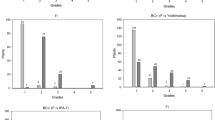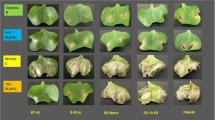Summary
Inheritance of black leaf mold (BLM) (caused by Pseudocercospora fuligena) resistance was studied in four crosses involving two resistant Lycopersicon accessions (PI134417, L. hirsutum and PI254655, L. esculentum) and four susceptible Asian Vegetable Research and Development Center tomato lines (CLN657BC1F2-267-0-3-12-7, CL143-0-10-3-0-1-10, CLN698BC1F2-358-4-13 and CL5915-93D4-1-0-3). For each cross, six generations, i.e. P1, P2, F1, F2, BC1F1 and BC1F2 were evaluated following inoculations with isolate Pf-2 of P. fuligena. Chi-square analyses of the data based on the ratio of resistant to susceptible plants in the F2 in three of four crosses gave a good fit to a segregation ratio of 1 R : 15 S, and BC1F2 data in three of four crosses gave an acceptable fit to the segregation ratio of 1 R : 63 S. The results indicate that resistance to BLM may be conditioned by two recessive genes acting epistatically in both PI134417 and PI254655.
Similar content being viewed by others
References
Anonymous, 1990. Screening for resistance to Cercospora leaf spot (Cercospora fuligena). In: 1987 Progress Report, Asian Vegetable Research and Development Center, Shanhua, Tainan, Taiwan, R.O.C., pp. 270–271.
Blazquez C.H. & S.A. AlfieriJr., 1974. Cercospora leaf mold of tomato. Phytopathology 64: 443–445.
Fehr W.R., 1987. Principles of Cultivar Development. vol I. Theory and Technique. 536 pp. Macmillan Publishing Company, New York.
Hartman G.L., S.C. Chen & T.C. Wang, 1991. Cultural studies and pathogenicity of Pseudocercospora fuligena. Plant Dis. 75: 1060–1063.
Hartman G.L. & T.C. Wang, 1992. Black leaf mold development and its effect on tomato yield. Plant Dis. 76: 462–465.
Hartman G.L. & T.C. Wang, 1993. Resistance in Lycopersicon species to black leaf mold caused by Pseudocercospora fuligena. Euphytica 71: 125–130.
Hooker A.L., 1983. Breeding to control pests. In: D.R. Wood (Ed.), Crop Breeding, pp. 199–230. Am. Soc. of Agron., Madison, Wis.
Hsieh W.H. & T.K. Goh, 1990. Cercospora and Similar Fungi from Taiwan. Maw Chang Book Company, Taipei, Taiwan. 376 pp.
Jones J.B., J.P. Jones, R.E. Stall & T.A. Zitter, 1991. Compendium of Tomato Diseases. American Phytopathological Society. St. Paul, MN.
Little T.M. & F.J. Hills, 1978. Agricultural Experimentation, Design and Analysis, John Wiley & Sons, Inc., Canada. 350 pp.
Magda T.R. & F.C. Quebral, 1970. Effect of exposure period in moist chamber on Cercospora fuligena spore germination, penetration, infection and sporulation on tomato. Philipp. Phytopathol. 6: 75–82.
Mohanty U.N. & N.N. Mohanty, 1955. Cercospora leaf mold of tomato. Sci. Cult. 21: 269–270.
Roldan E.F., 1938. New or noteworthy lower fungi of the Philippine Islands. II. Philipp. J. Sci. 66: 7–17.
Sherf A.F. & A.A. MacNab, 1986 Cercospora leaf mold. pp. 668–669. In: Vegetable Diseases and Their Control. John Wiley & Sons, New York.
Yamada S., 1951. New disease of tomato (Lycopersicon esculentum Mill.) caused by Cercospora sp. Phytopathol. Soc. Japan, Ann. 15: 13–18.
Author information
Authors and Affiliations
Rights and permissions
About this article
Cite this article
Wang, T.C., Black, L.L., Hsieh, W.H. et al. Inheritance of black leaf mold resistance in tomato. Euphytica 86, 111–115 (1995). https://doi.org/10.1007/BF00022016
Received:
Accepted:
Issue Date:
DOI: https://doi.org/10.1007/BF00022016




